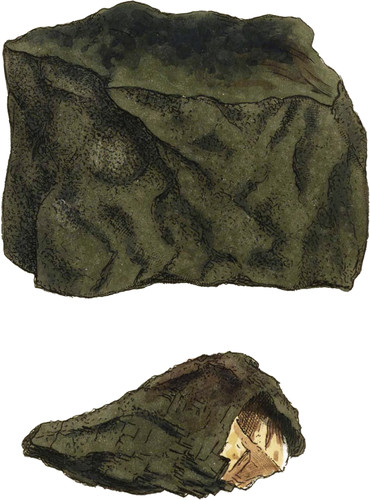 Enlarge
Enlarge
British Mineralogy
Subsulphuret of Iron, or Magnetical Pyrites
- Class 3. Metals.
- Order 1. Homogeneous.
- Gen. 7. Iron.
- Spec. Subsulphuret.
- Syn. Magnetical Pyrites. Hatchett in Phil. Trans. for 1804.
The Rev. H. Davies of Beaumaris favoured me with these specimens from the foot of the mountain Moël Ælia in Caernarvonshire, from whence some specimens were sent by the Hon. Colonel Robert Greville to his brother the Hon. Charles Greville, about the year 1798, as mentioned by Charles Hatchett, Esq., who has published so able an account of it, with the analysis, in the Philosophical Transactions for 1804, and from which I subjoin a part of the description, with a reference to the more perfect one.
Mr. Hatchett observes that this Pyrites has been hitherto found only in some parts of Norway, Silesia, Bavaria, and at Mebendorf and Brichenbrun in Saxony. He found the British specimens to be magnetical, agreeing with others in every particular. A piece, nearly two inches square, acted upon the needle at a distance of four inches. The powder, which is blackish grey with but little metallic lustre, is immediately taken up by a common magnet, but the Pyrites does not act thus upon the powder, nor on iron filings, unless it has been placed for some time between magnetical bars: then indeed it acts powerfully, turns the needle completely round, attracts and takes up iron filings, and seems permanently to retain this addition to its original power. In the specimens which he obtained, the north pole was the strongest.
From the appearance of those parts of the Magnetical Pyrites which have been exposed to the weather, it seems to be liable to oxygenizement, but not to vitriolization.
By analysis, Mr. Hatchett found it to contain
| Sulphur | 36.50 |
| Metallic Iron | 63.50 |
| 100.00 |
At a temperature of 63° the Spec. Grav. was 4318. It has been found to agree precisely with artificial Sulphuret of Iron, and it is fairly concluded that its proportions are probably subjected to certain laws, especially during its formation in the humid way, always acting in an invariable manner: and it is also found that Iron, when naturally or artificially combined with 36.50 or 37 per cent, of Sulphur, is not only still capable of receiving the magnetic fluid, but is also rendered capable of retaining it, and that beyond 45.30 or 46 per cent, of Sulphur, as in common Pyrites, all susceptibility of the magnetic influence seems to be destroyed. This and other proofs of certain proportions of mixtures having a peculiar effect upon the magnetic property of Iron, stamp a great value upon these researches.
I have a specimen showing the oxygenizement by moisture on the surface, having taken the impressions of the grass near which it lay; and I find that a fresh fracture is of a yellowish grey, but soon tarnishes.
The upper figure represents part of a stratified piece, which shows the fresh fracture with a surface that has an aggregated appearance; but this does not arise from any mixture.
The lower specimen, having a smoother fracture, shows it better, and has a tendency towards a cubic crystallization, which would seem to mark its relationship to common Pyrites, although they are nevertheless sufficiently distinct.
The upper specimen, figured at tab. 30, is nearly of the sort of Pyrites spoken of by Mr. Hatchett as accompanying this magnetical kind. It is also accompanied by Lapis Ollaris or Potstone, though not of the best sort. I find Yellow Copper Ore and Sulphuret of Lead attached to some of my specimens.
I have some of the magnetic part of the rock from Wicklow in Ireland, which has a distant resemblance to Magnetic Pyrites, but is duller, greyish or blackish, and does not in common fly to the magnet so readily.

